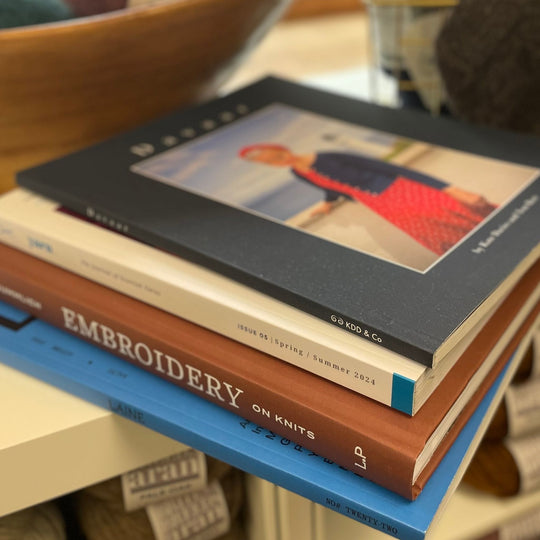Embroider Your Knits! by designer Mona Zillah
Duplicate Stitch and embroidery are my new favourite ways to show off my handknits. They add a bit of colour and a beautiful finishing detail to a flower or say, a chicken! This post focuses on embroidery.
First of all, know this is a bit of fun and easy to sew and rip, so you can really experiment. Sometimes I go into a project with the idea of additions, but many times I just add a little something to take a break from ribbing or sleeve knitting. I am by no means a pro, I tend to use 3 sts – the Lazy Daisy petal, Straight Stitch, and Staggered Straight Stitch (basically a cluster of Stem Stitches). There are a number of books and tutorials, if you would like to try some of the fancier elegant stitches.
Getting started (these will assume you are using a Shetland, Icelandic, or similarly sticky yarn):
I will refer to embroidery stitches as ‘sts’, embroidery yarn as ‘yarn’, and the knit itself as ‘fabric’ or ‘chains’. The needle refers to a sewing needle (rather than a knitting needle, leave those in your bag at the minute!).
- Select the area to be worked, and a few details you would like to include – leaves, flowers, starburst, insects, etc. You may draw the motif out a bit, if you like, on paper. Since knit fabric is basically a grid, you may, more accurately, draw using graph paper. But feel free to just wing it and see where each st leads you.
- You may want to block or at least steam press the fabric, so you can see the chains well and it lays flat.
- Select your needle. I use darning and sharp needles depending on the st I am working. The darning needles (with a blunt tip) allow you to work inside a chain and open it up for an eyelet (and are ideal for Duplicate St). The sharper needle gets your working yarn within the fabric, rather than between chains. This will secure your embroidery without holes.
- Select your yarn. Your motif should dictate the thickness of your yarn. For my TWT KAL sweater, I used a single strand of Shetland jumper weight on Plotulopi (a worsted/Aran weight) for everything but the ladybird beetle. For the ladybird, I held the yarn double and the face and spots single. As far as colours go – you may need to make a st or two to really see how it looks on your fabric. Particularly with subtle differences.
Once you have your basic idea planned out, you are ready to thread your needle and begin.
I usually cut/break a piece of yarn 10 – 12 in/25.5 – 30.5 cm, but nothing longer; the yarn tends to stick to itself (particularly that end that has gone through the needle and is just hanging there). I pull the yarn through carefully and slowly as I work. I thread my needle and come from the back (WS) and leave a bit of a tail - about 1.5in/3cm for my first st and hold it to the back, as I pull the yarn through. This allows me to rip out easily, if this is not quite the place I wanted to begin, the colour is not quite right, or it simply is a weird looking st. (Once I have the beginning st and am ready to get going with the motif, I weave the yarn in to ‘knot’ the end in place and continue from there.)
I usually work small and build from the first element. I hold my piece gently in my hands, as this gives me the ability to turn easily and have a ‘feel’ for the stretch of the fabric. Some people like to secure their piece. You will find what works for you.
Work your sts rather loose, your fabric is elastic, and you don’t want your embroidery puckering your fabric, plus you can still stretch your knit fabric over any curves you have. When you do a proper blocking, the fibres will interlock nicely.
I've put together a pattern for the coaster pictured here called the Little Enchanting Object, which you can download free either from my Ravelry, Lovecrafts, or Payhip shops.
The flower uses the Lazy Daisy st. The leaf uses the Staggered Straight st. And finally, the ladybird uses the Staggered Straight st and a number of small Straight sts.

Once you have completed your bits, break your yarn, if you can without pulling the embroidery too tightly, or cut the yarn. Then, weave in the end as you would any end of your knitting. Block or gently steam press and you are ready to show it off out on the town or in the woods!
Mona creates patterns for hand knitters blending traditional and contemporary styles. She focuses on colourwork and designs patterns that are easily adjustable for a personal fit. She draws inspiration from the world around us all and supports ethical sourcing and climate/people conscious yarns and notions!
 Mona is seen here wearing her design "Hillary Muff and the magic fungi"
Mona is seen here wearing her design "Hillary Muff and the magic fungi"






























1 Comment -
Alex •
Great by all means and a very informative blog. I’ve learned something new today, keep sharing worthy info like this!
Machine Embroidery Designs